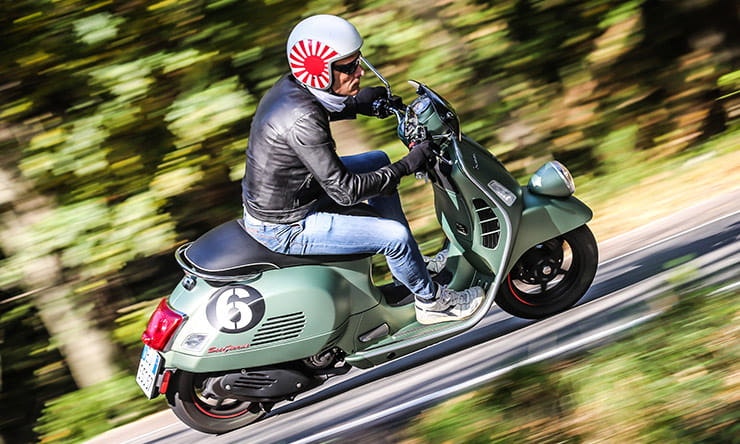10 Things you never knew about Vespa
By Phil West
Freelance journalist/editor/author
24.08.2016
One thing you probably did already know was that 2016 marks the 70th anniversary of the iconic Vespa scooter. Launched in 1946, the powered small wheeler became hugely popular, came to epitomize scooters and scooter culture, spawned a hoist of imitators around the globe and lives on today as the ultimate in fashionable two-wheel commuters. But here’s 10 things you maybe didn’t know about it.
1. It was born out of war
Piaggio, the company behind the Vespa, had begun in shipbuilding in the 19th century before expanding into rail and, in the 20th century, aircraft. Because of this, during WW2, its factories were extensively damaged. Immediately post-war these were rebuilt with help from the Allies but, like many Axis former aircraft manufacturers, were barred from plane production so instead turned to motorcycle manufacture to meet the huge need for cheap transport.
2. It was inspired by an American military bike
The Cushman Model 53, better known as the Airborne, was a rugged, lightweight motorcycle with small wheels, which was designed to be parachuted into war zones during WW2. Many were dropped into Italy around Milan and Turin to be used by Italian resistance fighters and, as a result, were a common sight.
3. Its designer hated motorcycles
Enrico Piaggio asked accomplished engineer Corradino D'Ascanio to design the new machine. D’Ascanio was a radical free spirit who had built his own glider at 15 and designed Italy's first helicopter. Unfortunately, however, he didn’t like conventional motorcycles, considering them bulky and dirty, so set about making a two-wheeler that was different. He moved the gears to the handlebars, made it a ‘step thru’ with leg shields and footboards so that women could ride it in skirts and hid the engine away to keep the riders and their clothes clean.
4. It was almost an MV Agusta
The Vespa name has a story all its own. Originally merely a model name rather than a whole brand it came about when bosses noted that early versions of the two stroke sounded like a buzzing wasp. Vespa is Italian for wasp. Ironically, though, even then it almost didn’t happen. Fledgling MV Agusta, who also built its first motorcycle around the same time, also wanted to call its newcomer the Vespa. Unfortunately for them Piaggio had registered the name first.
5. Some of its success is down to Hollywood
Although an instant hit with the public, the Vespa’s success was accelerated through active promotion (or some of the earliest ‘product placement’) in a series of popular movies. Stars like Anita Ekberg and Audrey Hepburn zipped around Italy on the back of Vespas in La Dolce Vita and Roman Holiday respectively, while many film productions were loaned Vespas for use during shooting – most notably Charlton Heston and Stephen Boyd during the filming of Ben Hur.
6. It’s become more popular than the Model T…
Over the 70 years since, the Vespa has proved not just popular but to be one of the best-selling powered two-wheelers of all time with over 18 million examples sold (that’s more than the legendary Model T Ford), but with Vespas also built under licence in not just India but also Indonesia and even Taiwan. What’s more, over 150 different models have been produced over those seven decades.
7. It’s more copied than any other motorcycle
Huge popularity inevitably inspires imitation, but the Vespa’s ‘imitators’ have been far more numerous and varied than most with even the likes of Germany’s Zundapp and Triumph with its Tigress both having a stab in the 1950s. Copies continue to this day. In 2013, Italian police famously seized 11 machines from seven different Chinese manufacturers who had the gall (or ignorance) to display their wares alongside Vespa at the huge EICMA show in Piaggio’s own back yard.
8. The UK is its second largest market
With Italy being the home of the scooter the fact that its love affair with the small two-wheelers continues to the extent that its Vespa’s biggest market by far is no surprise. But what may be is that the UK comes second. There’s been a large scooter culture here ever since the late ‘50s, partly due to the ‘mod’ scene and the Vespa in particular maintains an image as a cool commuter, particularly in London where it remains the vehicle of choice for many celebrities such as Simon Cowell
9. There’s currently 12 different Vespas
The days when there was just one Vespa model are long gone. Indeed, a second Vespa model was added as early as 1947 and there’s has been growing family of Vespa ever since. Today, in the UK, 12 different models are offered in six different families: Primavera (50, 125 and 150); Sprint (50, 125 and 150); GTS (300); GTS Super (125 and 300); PX (125 and 150) and 946 (125) all ranging from 50cc two-strokes to 300cc four-strokes.
10. The current 946 was inspired by the 1946 original
Vespa’s current range-topper, the 946, was conceived and designed to honour and celebrate the original Vespa. From its handlebars to the seat, the lines are intended to evoke the style of the original yet in its execution and quality it’s very different – no simple, utilitarian machine this, instead the 946 is a luxury machine bristling with classy touches like LED lights and a hand-stitched seat.
Share on social media:
